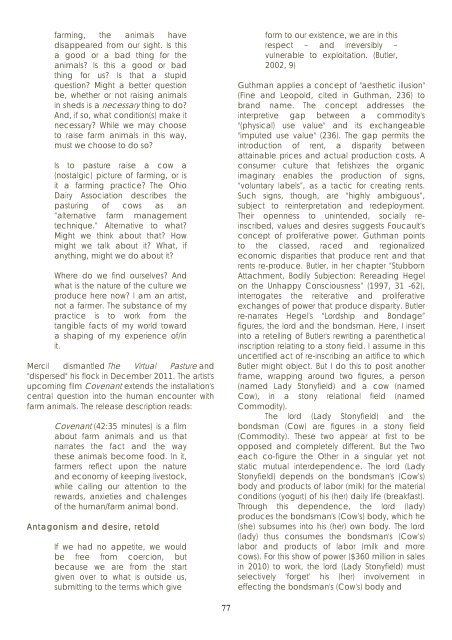Marketing Animals - Antennae The Journal of Nature in Visual Culture
Marketing Animals - Antennae The Journal of Nature in Visual Culture
Marketing Animals - Antennae The Journal of Nature in Visual Culture
Create successful ePaper yourself
Turn your PDF publications into a flip-book with our unique Google optimized e-Paper software.
farm<strong>in</strong>g, the animals have<br />
disappeared from our sight. Is this<br />
a good or a bad th<strong>in</strong>g for the<br />
animals? Is this a good or bad<br />
th<strong>in</strong>g for us? Is that a stupid<br />
question? Might a better question<br />
be, whether or not rais<strong>in</strong>g animals<br />
<strong>in</strong> sheds is a necessary th<strong>in</strong>g to do?<br />
And, if so, what condition(s) make it<br />
necessary? While we may choose<br />
to raise farm animals <strong>in</strong> this way,<br />
must we choose to do so?<br />
Is to pasture raise a cow a<br />
(nostalgic) picture <strong>of</strong> farm<strong>in</strong>g, or is<br />
it a farm<strong>in</strong>g practice? <strong>The</strong> Ohio<br />
Dairy Association describes the<br />
pastur<strong>in</strong>g <strong>of</strong> cows as an<br />
“alternative farm management<br />
technique.” Alternative to what?<br />
Might we th<strong>in</strong>k about that? How<br />
might we talk about it? What, if<br />
anyth<strong>in</strong>g, might we do about it?<br />
Where do we f<strong>in</strong>d ourselves? And<br />
what is the nature <strong>of</strong> the culture we<br />
produce here now? I am an artist,<br />
not a farmer. <strong>The</strong> substance <strong>of</strong> my<br />
practice is to work from the<br />
tangible facts <strong>of</strong> my world toward<br />
a shap<strong>in</strong>g <strong>of</strong> my experience <strong>of</strong>/<strong>in</strong><br />
it.<br />
Mercil dismantled <strong>The</strong> Virtual Pasture and<br />
"dispersed" his flock <strong>in</strong> December 2011. <strong>The</strong> artist's<br />
upcom<strong>in</strong>g film Covenant extends the <strong>in</strong>stallation's<br />
central question <strong>in</strong>to the human encounter with<br />
farm animals. <strong>The</strong> release description reads:<br />
Covenant (42:35 m<strong>in</strong>utes) is a film<br />
about farm animals and us that<br />
narrates the fact and the way<br />
these animals become food. In it,<br />
farmers reflect upon the nature<br />
and economy <strong>of</strong> keep<strong>in</strong>g livestock,<br />
while call<strong>in</strong>g our attention to the<br />
rewards, anxieties and challenges<br />
<strong>of</strong> the human/farm animal bond.<br />
Antagonism and desire, retold<br />
If we had no appetite, we would<br />
be free from coercion, but<br />
because we are from the start<br />
given over to what is outside us,<br />
submitt<strong>in</strong>g to the terms which give<br />
77<br />
form to our existence, we are <strong>in</strong> this<br />
respect – and irreversibly –<br />
vulnerable to exploitation. (Butler,<br />
2002, 9)<br />
Guthman applies a concept <strong>of</strong> "aesthetic illusion"<br />
(F<strong>in</strong>e and Leopold, cited <strong>in</strong> Guthman, 236) to<br />
brand name. <strong>The</strong> concept addresses the<br />
<strong>in</strong>terpretive gap between a commodity's<br />
"(physical) use value" and its exchangeable<br />
"imputed use value" (236). <strong>The</strong> gap permits the<br />
<strong>in</strong>troduction <strong>of</strong> rent, a disparity between<br />
atta<strong>in</strong>able prices and actual production costs. A<br />
consumer culture that fetishizes the organic<br />
imag<strong>in</strong>ary enables the production <strong>of</strong> signs,<br />
“voluntary labels”, as a tactic for creat<strong>in</strong>g rents.<br />
Such signs, though, are “highly ambiguous”,<br />
subject to re<strong>in</strong>terpretation and redeployment.<br />
<strong>The</strong>ir openness to un<strong>in</strong>tended, socially re<strong>in</strong>scribed,<br />
values and desires suggests Foucault’s<br />
concept <strong>of</strong> proliferative power. Guthman po<strong>in</strong>ts<br />
to the classed, raced and regionalized<br />
economic disparities that produce rent and that<br />
rents re-produce. Butler, <strong>in</strong> her chapter “Stubborn<br />
Attachment, Bodily Subjection: Reread<strong>in</strong>g Hegel<br />
on the Unhappy Consciousness” (1997, 31 -62),<br />
<strong>in</strong>terrogates the reiterative and proliferative<br />
exchanges <strong>of</strong> power that produce disparity. Butler<br />
re-narrates Hegel’s “Lordship and Bondage”<br />
figures, the lord and the bondsman. Here, I <strong>in</strong>sert<br />
<strong>in</strong>to a retell<strong>in</strong>g <strong>of</strong> Butler's rewrit<strong>in</strong>g a parenthetical<br />
<strong>in</strong>scription relat<strong>in</strong>g to a stony field. I assume <strong>in</strong> this<br />
uncertified act <strong>of</strong> re-<strong>in</strong>scrib<strong>in</strong>g an artifice to which<br />
Butler might object. But I do this to posit another<br />
frame, wrapp<strong>in</strong>g around two figures, a person<br />
(named Lady Stonyfield) and a cow (named<br />
Cow), <strong>in</strong> a stony relational field (named<br />
Commodity).<br />
<strong>The</strong> lord (Lady Stonyfield) and the<br />
bondsman (Cow) are figures <strong>in</strong> a stony field<br />
(Commodity). <strong>The</strong>se two appear at first to be<br />
opposed and completely different. But the Two<br />
each co-figure the Other <strong>in</strong> a s<strong>in</strong>gular yet not<br />
static mutual <strong>in</strong>terdependence. <strong>The</strong> lord (Lady<br />
Stonyfield) depends on the bondsman's (Cow’s)<br />
body and products <strong>of</strong> labor (milk) for the material<br />
conditions (yogurt) <strong>of</strong> his (her) daily life (breakfast).<br />
Through this dependence, the lord (lady)<br />
produces the bondsman's (Cow’s) body, which he<br />
(she) subsumes <strong>in</strong>to his (her) own body. <strong>The</strong> lord<br />
(lady) thus consumes the bondsman's (Cow’s)<br />
labor and products <strong>of</strong> labor (milk and more<br />
cows). For this show <strong>of</strong> power ($360 million <strong>in</strong> sales<br />
<strong>in</strong> 2010) to work, the lord (Lady Stonyfield) must<br />
selectively ‘forget’ his (her) <strong>in</strong>volvement <strong>in</strong><br />
effect<strong>in</strong>g the bondsman's (Cow’s) body and












